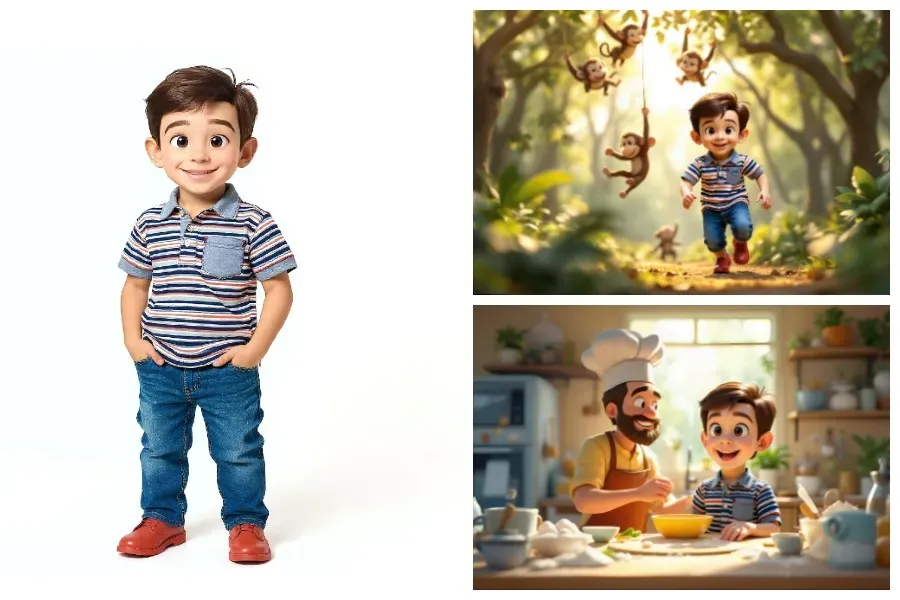Noob’s guide to creating a custom Storybook for your Kid in three steps
Stories aren't just entertainment - they're a gateway to imagination, empathy, and learning. A good story can spark curiosity in science, inspire a love for music, or even help kids process emotions. But when a story is about them, with characters that look like them or share their quirks, the connection is magical. It's like giving your child both a mirror and a window - one that reflects who they are and shows them who they can become.

So if you've ever thought, "Wouldn't it be cool if my kid could be the main character in their own fairytale?" - you're in the right place.
Tools You'll Need
I'll keep this guide simple. That said, creating a storybook that truly connects with your child does take effort and thoughtful planning. But when done right, the result can be deeply joyful and inspiring. In this blog, I'll focus on the overall process. In a future post, I'll explore how to personalize the story further by incorporating elements from your child's life. You don't need to be a designer or coder. Here are the three tools we'll use:
- ChatGPT - For writing the story, designing characters, and coming up with creative ideas.
- TheFluxTrain - A platform I built to cartoonize real people and pets, and create illustrations for your story featuring custom characters (kids, pets, you, etc.).
- Canva - To compile your images and text into a beautiful, ready-to-share storybook layout. You can also use it to print physical copies.
You can view the finished storybook as a PDF on your iPad or tablet.
Step 1: Story Ideation with ChatGPT
Start by thinking about your child's world. What do they love? Dinosaurs? Rockets? Talking animals? Silly wizards? Now, head over to ChatGPT and use a simple prompt like: create a script for a story about a boy. he is the hero, and fights a villain to do good. involve simple character. Its a story for 5 years old ChatGPT will quickly generate a complete story. Don't worry if it's not perfect - you can ask it to tweak the tone, add humor, or shorten it. This is your starting point. You can also ask ChatGPT to include moral lessons or values. Once the story is finalized, ask it to generate a scene-by-scene script with descriptions for each illustration.
If you'd prefer to skip the story creation process, don't worry - I'll be adding a library of ready-made stories to TheFluxTrain that you can customize.
Step 2: Design your main character and the scene
Now that we have our story and script, we can move on to character design and scene creation. You'll need a paid account with TheFluxTrain for this step. While there are other tools out there that offer similar features, mine is specifically optimized for this workflow and is user-friendly. This step is divided into three parts:
- Character development and LoRA model creation
- Base scene generation
- Character swapping
Character Development and LoRA Creation
The goal here is to generate a character that looks and feels like your kid, and then train an AI model (LoRA) to reproduce that character in different scenes. Start with a high-quality image of the child, pet, or person you want to cartoonize. A full-body photo with a simple background is ideal, but portraits also work. Follow the video tutorial below to create your cartoon character. After completing this step, you'll have a cartoon version of your child on a plain white background, with outfits and accessories chosen by you. You'll also be able to generate multiple images of the character in simple scenes, showcasing a variety of poses, expressions, and settings.
Next, we train a LoRA model using those photos. A LoRA (Low-Rank Adaptation) model enables the AI to generate consistent character appearances across various settings.
Base Scene Generation
Using the script you created earlier, generate base scenes using a text-to-image model. These scenes will initially include placeholder characters, which you'll replace later. Open the Story Studio on TheFluxTrain, copy the first scene prompt, and click generate. Follow this video tutorial:
Try different text variations until you find the right style. Make sure the art style matches the one used for your character.
Character Swapping
Now, we'll replace placeholder characters with your custom ones using LoRA and inpainting. This is where TheFluxTrain offers a big advantage over other tools.
For a more detailed walkthrough:
Repeat this process for each scene in your story. At the end of this step, you'll have all the illustrated scenes you need to assemble your storybook.
Step 3: Assemble Into a Book
With your scenes ready: Open Canva and import your images and captions Arrange them into a page-by-page layout with child-friendly fonts and background designs Export the final result as a PDF for digital reading, or print it using services like Blurb or Printo
And just like that - your child now stars in their very own storybook! Bonus Step: You can add supporting characters like a talking dog or a magical bear without training additional LoRA models. Here's how: What's Next? There's so much creative potential once you've mastered this process. You can: Create stories that teach moral, ethical, or religious values Animate your characters and add voiceovers (coming soon to TheFluxTrain!) Build an entire series with recurring characters and themes
Thanks

